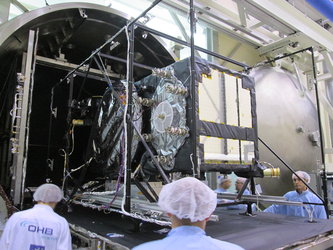Next two Galileo satellites reach Europe’s Spaceport
Europe’s ninth and tenth Galileo satellites have crossed the Atlantic, touching down in French Guiana ahead of their joint launch this September.
The delicate navigation satellites made their journey within environmentally controlled containers, having passed a gamut of tests to confirm their readiness for space.
The pair left ESA’s ESTEC technical centre in Noordwijk, the Netherlands, last Thursday by road for to Luxembourg Findel Airport.
On Friday morning the duo flew by Luxair 747 aircraft to Cayenne–Félix Eboué Airport in French Guiana, touching down at around midday local time.

They were then taken by road to the Guiana Space Centre, before being unboxed within an air-conditioned cleanroom, marking the start of their launch campaign.
September’s launch on a Soyuz rocket will see Europe’s own satnav constellation reach double figures. These are Flight Models 5 and 6 of the Full Operational Capability version.
Two more satellites are still at ESTEC, midway through being tested. Fourteen more are being built at OHB in Bremen, Germany, with their navigation payloads coming from Surrey Space Satellite Technology in Guildford, UK, and parts supplied from across Europe.

About Galileo
Europe’s satnav system will provide high-quality positioning, navigation and timing services to users across the world.
The full operational constellation will consist of 24 satellites plus six spares circling Earth in three orbits at 23 222 km altitude. Galileo will be interoperable with the US GPS and Russian Glonass systems, offering improved combined performance to users.
Galileo is a partnership between the European Commission and ESA, with a delegation agreement by which ESA acts as design and procurement agent on behalf of the Commission.
Initial services are due to begin next year.





